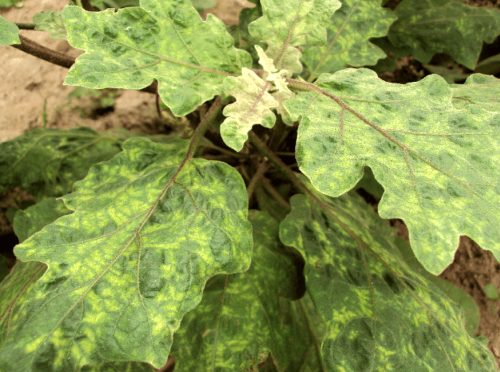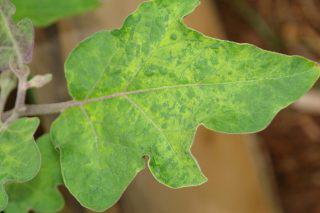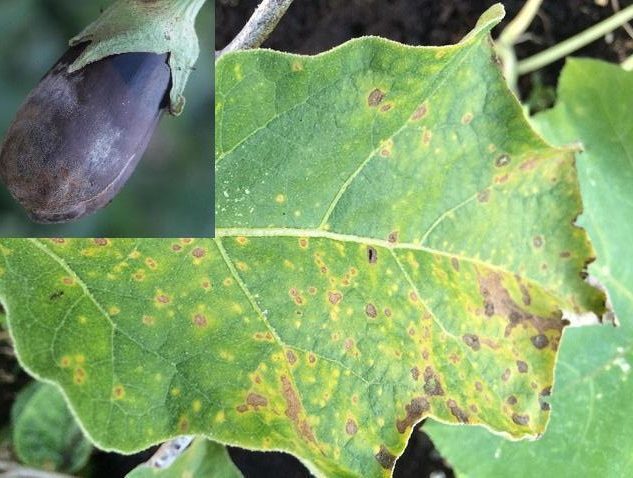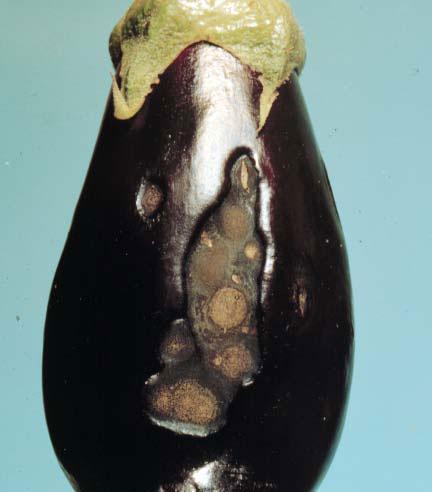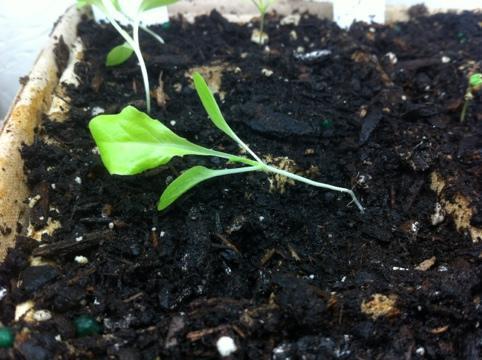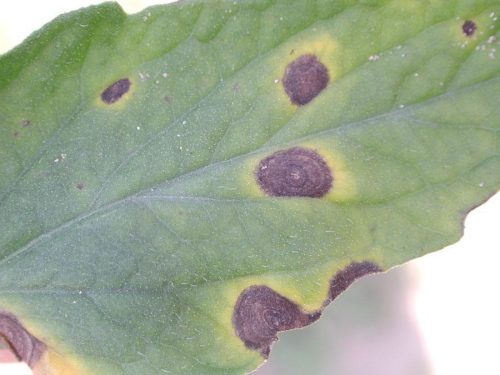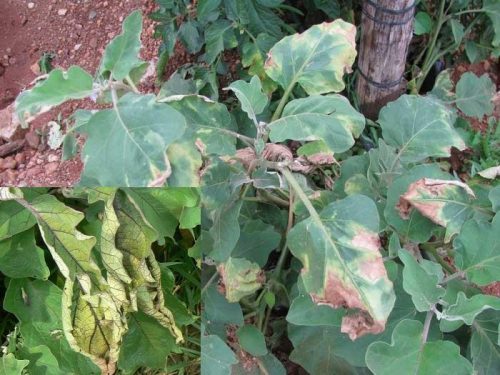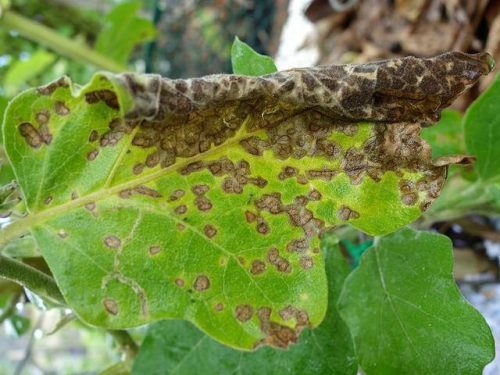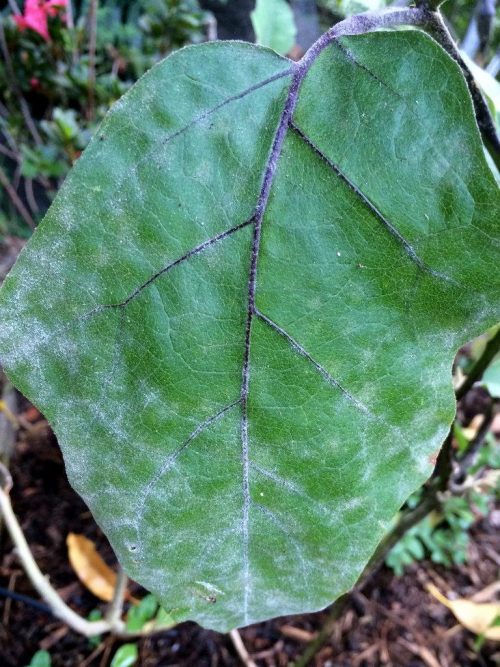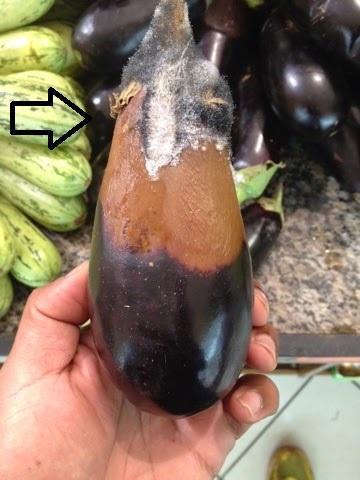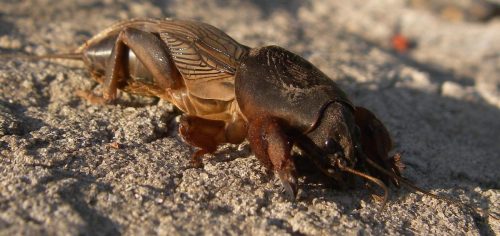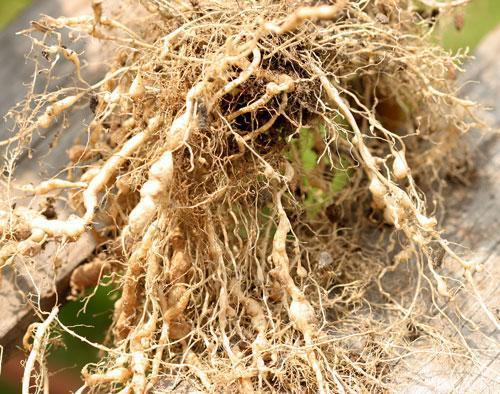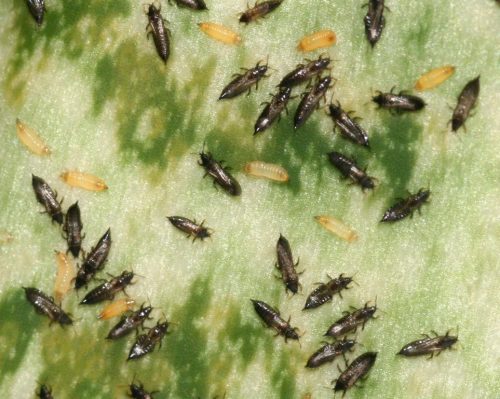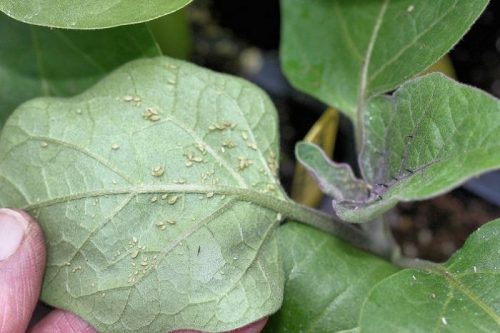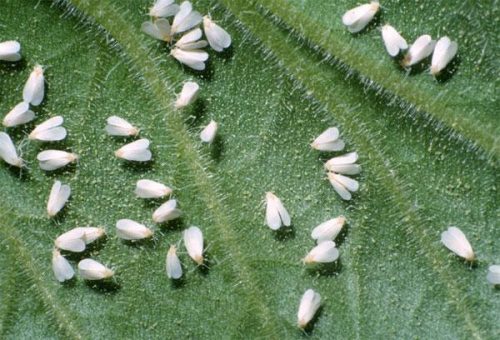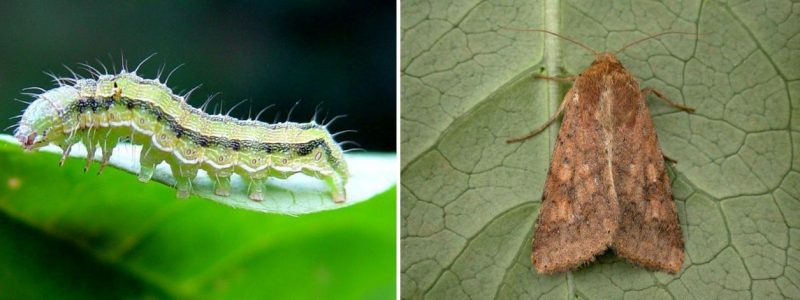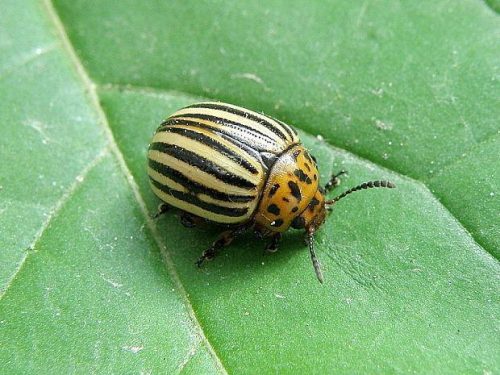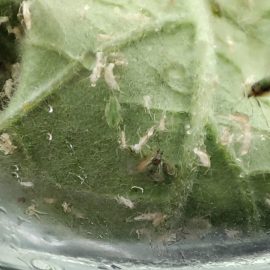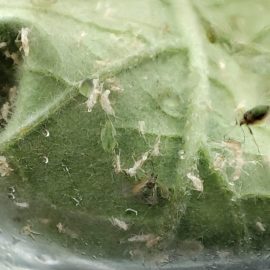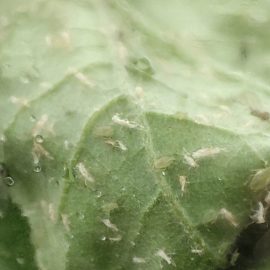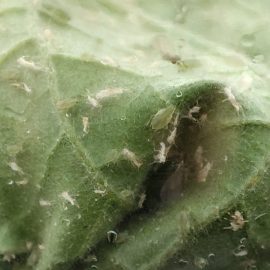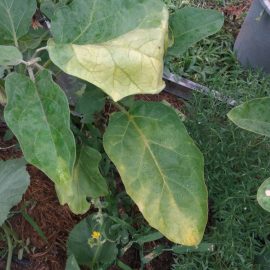Eggplant, treatments against pests and diseases
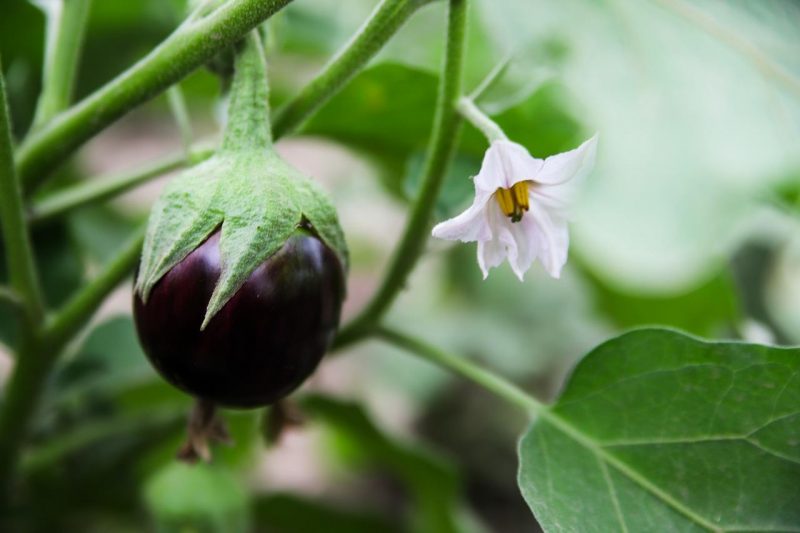
Eggplant (Solanum melongena) belongs to the Solanaceae family and is grown for its fruits. The plants are native to India, from where they spread to Europe and America. Initially, people were hesitant to use this plant because of the bitter taste of the raw fruit. But since the eighteenth century, it has gained popularity, now being one of the most consumed vegetables.
Eggplants have therapeutic properties and are recommended in the diet of people suffering from liver, pancreas, or heart diseases.
On the other hand, eggplant crops need to be protected from pests and diseases. It’s important to use the right treatments to keep your eggplants healthy and thriving.
THE MAIN DISEASES OF EGGPLANT
Viruses
Eggplant mottled dwarf virus
The leaves of affected plants show discoloration spots, and the plants acquire a marbled appearance. Also, the whole plant suffers from stunted growth accompanied by leaf twisting. Fruits become deformed and may show various spots. The virus is transmitted by various insects or by direct contact between plants.
Prevention and control measures:
- removing attacked plants from the crop;
- carrying out insecticide treatments to control the insect population.
Cucumber mosaic virus in eggplant
This virus was first identified on cucumber plants, but it attacks many crop plants including eggplants. The first symptoms include discolored spots that develop into burns arranged parallel to the veins. The plants produce a small amount of fruit, which shows yellow spots or stripes. In case of a severe attack, plants may wilt. The virus is transmitted by insects (aphids), and in winter it survives on infested perennial weeds.
Prevention and control measures:
- removing attacked plants from the crop;
- weed control;
- applying insecticides to keep the insect population under control.
Mycosis
Downy mildew (Phytophthora parasitica)
Large yellow spots appear on the upper part of the eggplant leaves. A whitish fuzz appears on the underside, next to the spots. In humid conditions, the spots expand and merge and the leaves dry out. The disease is transmitted by fungus spores carried by water droplets and wind.
Prevention and control measures:
- ensuring optimal ventilation;
- avoiding sprinkler irrigation;
- removing attacked plants from the crop;
- treatments with specific fungicides.
Recommended products
-
You can find products on a different store
Change Store -
You can find products on a different store
Change Store -
You can find products on a different store
Change Store -
You can find products on a different store
Change Store -
You can find products on a different store
Change Store -
You can find products on a different store
Change Store -
You can find products on a different store
Change Store -
You can find products on a different store
Change Store -
You can find products on a different store
Change Store -
You can find products on a different store
Change Store -
You can find products on a different store
Change Store -
You can find products on a different store
Change Store -
You can find products on a different store
Change Store -
You can find products on a different store
Change Store -
You can find products on a different store
Change Store -
You can find products on a different store
Change Store -
You can find products on a different store
Change Store -
You can find products on a different store
Change Store -
You can find products on a different store
Change Store -
You can find products on a different store
Change Store -
You can find products on a different store
Change Store -
You can find products on a different store
Change Store -
You can find products on a different store
Change Store -
You can find products on a different store
Change Store
Anthracnose (Colletotrichum melongena)
The first symptoms show up as circular brown spots on the fruit. Attacked tissues sink and rot. The fungus overwinters on plant debris on the soil surface and on infected seeds.
Prevention and control measures:
- gathering and destroying plant debris after harvest;
- removing affected fruit from the crop;
- eggplant treatments with specific fungicides.
Recommended products
-
You can find products on a different store
Change Store -
You can find products on a different store
Change Store -
You can find products on a different store
Change Store -
You can find products on a different store
Change Store -
You can find products on a different store
Change Store -
You can find products on a different store
Change Store -
You can find products on a different store
Change Store -
You can find products on a different store
Change Store -
You can find products on a different store
Change Store -
You can find products on a different store
Change Store -
You can find products on a different store
Change Store -
You can find products on a different store
Change Store -
You can find products on a different store
Change Store -
You can find products on a different store
Change Store -
You can find products on a different store
Change Store -
You can find products on a different store
Change Store -
You can find products on a different store
Change Store -
You can find products on a different store
Change Store -
You can find products on a different store
Change Store -
You can find products on a different store
Change Store -
You can find products on a different store
Change Store -
You can find products on a different store
Change Store -
You can find products on a different store
Change Store -
You can find products on a different store
Change Store
Damping-off (Phythium spp.)
It is one of the most significant diseases of eggplant seedlings. It manifests from the germinating and sprouting stage to the 2-3 true leaf stage. When attacked, the stem tissues above the soil become blackened, watery, and decay. The disease outbreak is favored by temperatures between 18-30 °C and humidity above 90%.
Prevention and control measures:
- removing plants from the crop and disinfecting the soil;
- disinfecting the substrate and treating the seeds before sowing;
- avoiding overwatering;
- eggplant treatments with specific fungicides.
Recommended products
-
You can find products on a different store
Change Store -
You can find products on a different store
Change Store -
You can find products on a different store
Change Store -
You can find products on a different store
Change Store -
You can find products on a different store
Change Store -
You can find products on a different store
Change Store -
You can find products on a different store
Change Store -
You can find products on a different store
Change Store -
You can find products on a different store
Change Store -
You can find products on a different store
Change Store -
You can find products on a different store
Change Store -
You can find products on a different store
Change Store -
You can find products on a different store
Change Store -
You can find products on a different store
Change Store -
You can find products on a different store
Change Store -
You can find products on a different store
Change Store -
You can find products on a different store
Change Store -
You can find products on a different store
Change Store -
You can find products on a different store
Change Store -
You can find products on a different store
Change Store -
You can find products on a different store
Change Store -
You can find products on a different store
Change Store -
You can find products on a different store
Change Store -
You can find products on a different store
Change Store
Leaf blight (Alternaria dauci)
Large, circular, brown spots appear on the affected leaves, with concentric circles on the surface. Affected tissues dry out and fall off the plant. Large spots may appear on the fruit, where the tissue sinks. The fungus overwinters on plant debris on the soil surface and spreads during vegetation by wind- and water-borne spores.
Prevention and control measures:
- gathering and destroying plant debris after harvesting;
- avoiding sprinkler irrigation;
- eggplant treatments with specific fungicides.
Recommended products
-
You can find products on a different store
Change Store -
You can find products on a different store
Change Store -
You can find products on a different store
Change Store -
You can find products on a different store
Change Store -
You can find products on a different store
Change Store -
You can find products on a different store
Change Store -
You can find products on a different store
Change Store -
You can find products on a different store
Change Store -
You can find products on a different store
Change Store -
You can find products on a different store
Change Store -
You can find products on a different store
Change Store -
You can find products on a different store
Change Store -
You can find products on a different store
Change Store -
You can find products on a different store
Change Store -
You can find products on a different store
Change Store -
You can find products on a different store
Change Store -
You can find products on a different store
Change Store -
You can find products on a different store
Change Store -
You can find products on a different store
Change Store -
You can find products on a different store
Change Store -
You can find products on a different store
Change Store -
You can find products on a different store
Change Store -
You can find products on a different store
Change Store -
You can find products on a different store
Change Store
Fusarium and Verticillium wilt (Fusarium oxysporum and Verticillium albo-atrum)
The first symptoms appear with the first fruits. The leaves at the base of the plant turn yellow and wilt, then dry up and fall off. The fruit shrivels and can no longer be used. The root system becomes brown and cracked. By making sections through the stem it is possible to see the browned plant vessels. The fungus lives for a long time on the plant debris of affected plants, but also in the soil.
Prevention and control measures:
- correct crop rotation (eggplants cannot return to the same land for 4 years);
- rational irrigation;
- balanced fertilisation;
- chemical treatments applied to the soil with specific fungicides.
Recommended products
-
You can find products on a different store
Change Store -
You can find products on a different store
Change Store -
You can find products on a different store
Change Store -
You can find products on a different store
Change Store -
You can find products on a different store
Change Store -
You can find products on a different store
Change Store -
You can find products on a different store
Change Store -
You can find products on a different store
Change Store -
You can find products on a different store
Change Store -
You can find products on a different store
Change Store -
You can find products on a different store
Change Store -
You can find products on a different store
Change Store -
You can find products on a different store
Change Store -
You can find products on a different store
Change Store -
You can find products on a different store
Change Store -
You can find products on a different store
Change Store -
You can find products on a different store
Change Store -
You can find products on a different store
Change Store -
You can find products on a different store
Change Store -
You can find products on a different store
Change Store -
You can find products on a different store
Change Store -
You can find products on a different store
Change Store -
You can find products on a different store
Change Store -
You can find products on a different store
Change Store
Cercospora leaf spot (Cercospora melongenae)
Small, circular, brownish spots appear on eggplant leaves, surrounded by a fine brown edge. The affected areas sink slightly into the tissue. The disease can be confused with downy mildew, but in the case of Cercospora leaf spot, no fuzz appears on the underside of the leaves. The fungus spreads by spores. They resist on plant debris on the soil surface and produce infections in subsequent years. High temperatures and the presence of water droplets on the leaves favor its occurrence.
Prevention and control measures:
- correct crop rotation;
- growing resistant eggplant varieties;
- avoiding sprinkler irrigation;
- collecting plant debris after harvest;
- eggplant treatments with specific fungicides.
Recommended products
-
You can find products on a different store
Change Store -
You can find products on a different store
Change Store -
You can find products on a different store
Change Store -
You can find products on a different store
Change Store -
You can find products on a different store
Change Store -
You can find products on a different store
Change Store -
You can find products on a different store
Change Store -
You can find products on a different store
Change Store -
You can find products on a different store
Change Store -
You can find products on a different store
Change Store -
You can find products on a different store
Change Store -
You can find products on a different store
Change Store -
You can find products on a different store
Change Store -
You can find products on a different store
Change Store -
You can find products on a different store
Change Store -
You can find products on a different store
Change Store -
You can find products on a different store
Change Store -
You can find products on a different store
Change Store -
You can find products on a different store
Change Store -
You can find products on a different store
Change Store -
You can find products on a different store
Change Store -
You can find products on a different store
Change Store -
You can find products on a different store
Change Store -
You can find products on a different store
Change Store
Powdery mildew (Leveillula taurica)
The fungus attacks all aerial organs of the plant, but noticeable symptoms are seen on the leaves. The attack starts on the basal leaves which become covered with a white mycelial web. The affected tissues turn brown and the leaves dry out completely. Affected plants form a small number of fruits, which mature very slowly. The fungus causes significant damage to eggplant crops in protected areas. In winter, the fungus spores live on plant debris on the soil surface. During vegetation, the disease is transmitted by spores carried by water droplets.
Prevention and control measures:
- avoiding sprinkler irrigation;
- removing plants from the crop;
- ensuring proper aeration;
- balanced fertilisation;
- growing resistant eggplant varieties;
- eggplant treatments with specific fungicides.
Recommended products
-
You can find products on a different store
Change Store -
You can find products on a different store
Change Store -
You can find products on a different store
Change Store -
You can find products on a different store
Change Store -
You can find products on a different store
Change Store -
You can find products on a different store
Change Store -
You can find products on a different store
Change Store -
You can find products on a different store
Change Store -
You can find products on a different store
Change Store -
You can find products on a different store
Change Store -
You can find products on a different store
Change Store -
You can find products on a different store
Change Store -
You can find products on a different store
Change Store -
You can find products on a different store
Change Store -
You can find products on a different store
Change Store -
You can find products on a different store
Change Store -
You can find products on a different store
Change Store -
You can find products on a different store
Change Store -
You can find products on a different store
Change Store -
You can find products on a different store
Change Store -
You can find products on a different store
Change Store -
You can find products on a different store
Change Store -
You can find products on a different store
Change Store -
You can find products on a different store
Change Store
Gray mold (Botrytis cinerea)
This fungus attacks eggplants grown in the field and protected spaces, under conditions of low light and high humidity. The symptoms can be seen on stems, leaf petioles, flowers, fruit, and leaves. Brown patches appear at the base of the stems, slightly sunken into the tissue. The attacked areas become covered with a greyish fuzz which eventually destroys them and the plant wilts. Attacked flowers rot and become covered with a greyish fuzz. If humidity remains high, the disease attacks the almost-ripe fruits. Moist spots appear, which are covered with a greyish fuzz. After the attack, the fruit is destroyed. The fungus lives on plant debris on the soil surface and its spores are carried to healthy plants by air currents and water droplets.
Prevention and control measures:
- removing attacked plants from the crop;
- gathering and destroying plant debris after harvesting;
- proper aeration;
- rational irrigation;
- eggplant treatments with specific fungicides.
Recommended products
-
You can find products on a different store
Change Store -
You can find products on a different store
Change Store -
You can find products on a different store
Change Store -
You can find products on a different store
Change Store -
You can find products on a different store
Change Store -
You can find products on a different store
Change Store -
You can find products on a different store
Change Store -
You can find products on a different store
Change Store -
You can find products on a different store
Change Store -
You can find products on a different store
Change Store -
You can find products on a different store
Change Store -
You can find products on a different store
Change Store -
You can find products on a different store
Change Store -
You can find products on a different store
Change Store -
You can find products on a different store
Change Store -
You can find products on a different store
Change Store -
You can find products on a different store
Change Store -
You can find products on a different store
Change Store -
You can find products on a different store
Change Store -
You can find products on a different store
Change Store -
You can find products on a different store
Change Store -
You can find products on a different store
Change Store -
You can find products on a different store
Change Store -
You can find products on a different store
Change Store
THE MAIN PESTS OF EGGPLANT
Mole cricket (Gryllotalpa gryllotalpa)
It has an omnivorous diet, feeding on plant substrate, live prey ( earthworms and various larvae) or insect remains. Damage is direct, by gnawing the root system. They dig up uncultivated seeds or young plants. Attacked plants wilt and bend to the ground.
Control measures:
- chemical treatments applied to the soil;
Nematodes
They are microscopic worms that attack most vegetable species. They have many generations per year and multiply very quickly. The larvae penetrate the root system and settle in the root vessels. During feeding, they secrete a toxin that causes tissue hypertrophy. Attacked plants stagnate in growth and eventually wither.
Control measures:
- correct crop rotation;
- growing resistant eggplant varieties;
- soil disinfection with specific products.
Recommended products
-
You can find products on a different store
Change Store -
You can find products on a different store
Change Store -
You can find products on a different store
Change Store -
You can find products on a different store
Change Store -
You can find products on a different store
Change Store -
You can find products on a different store
Change Store -
You can find products on a different store
Change Store -
You can find products on a different store
Change Store -
You can find products on a different store
Change Store -
You can find products on a different store
Change Store -
You can find products on a different store
Change Store -
You can find products on a different store
Change Store -
You can find products on a different store
Change Store -
You can find products on a different store
Change Store -
You can find products on a different store
Change Store -
You can find products on a different store
Change Store -
You can find products on a different store
Change Store -
You can find products on a different store
Change Store -
You can find products on a different store
Change Store -
You can find products on a different store
Change Store -
You can find products on a different store
Change Store -
You can find products on a different store
Change Store -
You can find products on a different store
Change Store -
You can find products on a different store
Change Store
Thrips
They are small insects, hardly visible to the naked eye, that attack a very large number of crop plants. They colonize the growing tips, flowers, and leaves, causing flower abortion and plant dwarfing. Thrips transmit a range of viruses.
Control measures:
- specific insecticide treatments;
- using sticky traps.
Recommended products
-
You can find products on a different store
Change Store -
You can find products on a different store
Change Store -
You can find products on a different store
Change Store -
You can find products on a different store
Change Store -
You can find products on a different store
Change Store -
You can find products on a different store
Change Store -
You can find products on a different store
Change Store -
You can find products on a different store
Change Store -
You can find products on a different store
Change Store -
You can find products on a different store
Change Store -
You can find products on a different store
Change Store -
You can find products on a different store
Change Store -
You can find products on a different store
Change Store -
You can find products on a different store
Change Store -
You can find products on a different store
Change Store -
You can find products on a different store
Change Store -
You can find products on a different store
Change Store -
You can find products on a different store
Change Store -
You can find products on a different store
Change Store -
You can find products on a different store
Change Store -
You can find products on a different store
Change Store -
You can find products on a different store
Change Store -
You can find products on a different store
Change Store -
You can find products on a different store
Change Store
They are polyphagous species that migrate from one plant to another or from one species to another. Aphids grow on wild flora and then move to cultivated species. They appear as colonies on the underside of leaves, on flowers or inflorescences, and young shoots. The insects feed on plant sap, stressing the plant. In case of a severe attack, the plants may die.
Control measures:
- specific insecticide treatments;
- using sticky traps.
Recommended products
-
You can find products on a different store
Change Store -
You can find products on a different store
Change Store -
You can find products on a different store
Change Store -
You can find products on a different store
Change Store -
You can find products on a different store
Change Store -
You can find products on a different store
Change Store -
You can find products on a different store
Change Store -
You can find products on a different store
Change Store -
You can find products on a different store
Change Store -
You can find products on a different store
Change Store -
You can find products on a different store
Change Store -
You can find products on a different store
Change Store -
You can find products on a different store
Change Store -
You can find products on a different store
Change Store -
You can find products on a different store
Change Store -
You can find products on a different store
Change Store -
You can find products on a different store
Change Store -
You can find products on a different store
Change Store -
You can find products on a different store
Change Store -
You can find products on a different store
Change Store -
You can find products on a different store
Change Store -
You can find products on a different store
Change Store -
You can find products on a different store
Change Store -
You can find products on a different store
Change Store
Greenhouse whitefly (Trialeurodes vaporariorum)
The pest thrives in greenhouse conditions all year round, and in the field only in summer. In the greenhouse it can develop 3-6 generations when conditions are favorable. Adults and larvae colonize leaves, often also the shoots. After the attack, the leaves become etiolated, dry and fall off.
Control measures:
- destroying plant debris after harvesting;
- disinsecting greenhouses and polyhouses before starting a new crop;
- treatments with specific insecticides;
- using sticky traps.
Recommended products
-
You can find products on a different store
Change Store -
You can find products on a different store
Change Store -
You can find products on a different store
Change Store -
You can find products on a different store
Change Store -
You can find products on a different store
Change Store -
You can find products on a different store
Change Store -
You can find products on a different store
Change Store -
You can find products on a different store
Change Store -
You can find products on a different store
Change Store -
You can find products on a different store
Change Store -
You can find products on a different store
Change Store -
You can find products on a different store
Change Store -
You can find products on a different store
Change Store -
You can find products on a different store
Change Store -
You can find products on a different store
Change Store -
You can find products on a different store
Change Store -
You can find products on a different store
Change Store -
You can find products on a different store
Change Store -
You can find products on a different store
Change Store -
You can find products on a different store
Change Store -
You can find products on a different store
Change Store -
You can find products on a different store
Change Store -
You can find products on a different store
Change Store -
You can find products on a different store
Change Store
Cotton bollworm (Helicoverpa armigera)
It is a polyphagous species, attacking over 120 species. The insect attacks vegetables grown in protected spaces, but also those grown in the field. The moth develops two generations per year and overwinters as a nymph in the soil. The larvae gnaw the leaf epidermis and then enter the fruit where they consume the flesh and seeds. Unfortunately, the fruit is no longer edible because it has been contaminated. One larva can destroy up to 10 fruits.
Control measures:
- chemical treatments with specific insecticides.
Recommended products
-
You can find products on a different store
Change Store -
You can find products on a different store
Change Store -
You can find products on a different store
Change Store -
You can find products on a different store
Change Store -
You can find products on a different store
Change Store -
You can find products on a different store
Change Store -
You can find products on a different store
Change Store -
You can find products on a different store
Change Store -
You can find products on a different store
Change Store -
You can find products on a different store
Change Store -
You can find products on a different store
Change Store -
You can find products on a different store
Change Store -
You can find products on a different store
Change Store -
You can find products on a different store
Change Store -
You can find products on a different store
Change Store -
You can find products on a different store
Change Store -
You can find products on a different store
Change Store -
You can find products on a different store
Change Store -
You can find products on a different store
Change Store -
You can find products on a different store
Change Store -
You can find products on a different store
Change Store -
You can find products on a different store
Change Store -
You can find products on a different store
Change Store -
You can find products on a different store
Change Store
Spidermites
These insects are very difficult to see with the naked eye. They are polyphagous species that attack many plants, both cultivated and wild species. They feed on the plant’s sap. After the attack, the leaves look parched, the flowers abort and the plant stagnates in growth.
Control measures:
- chemical treatments with specific insecticides.
Recommended products
-
You can find products on a different store
Change Store -
You can find products on a different store
Change Store -
You can find products on a different store
Change Store -
You can find products on a different store
Change Store -
You can find products on a different store
Change Store -
You can find products on a different store
Change Store -
You can find products on a different store
Change Store -
You can find products on a different store
Change Store -
You can find products on a different store
Change Store -
You can find products on a different store
Change Store -
You can find products on a different store
Change Store -
You can find products on a different store
Change Store -
You can find products on a different store
Change Store -
You can find products on a different store
Change Store -
You can find products on a different store
Change Store -
You can find products on a different store
Change Store -
You can find products on a different store
Change Store -
You can find products on a different store
Change Store -
You can find products on a different store
Change Store -
You can find products on a different store
Change Store -
You can find products on a different store
Change Store -
You can find products on a different store
Change Store -
You can find products on a different store
Change Store -
You can find products on a different store
Change Store
Colorado potato beetle (Leptinotarsa decemlineata)
Develop 1-3 generations per year, depending on environmental conditions. Overwinters as an adult in the soil, where it retreats from the second half of September to depths of 10-15 cm. Adults gnaw the leaves, producing irregular perforations on the blade surface and eventually even skeletonizing them. An adult can consume the entire leaf surface of an eggplant in only 2-3 days. The young larvae pierce the leaves into small holes, and as they get older, they gnaw the leaves entirely, sometimes even the shoots.
Control measures:
- correct crop rotation (eggplants can return to the same field after 4 years);
- chemical treatments with specific insecticides.
Recommended products
-
You can find products on a different store
Change Store -
You can find products on a different store
Change Store -
You can find products on a different store
Change Store -
You can find products on a different store
Change Store -
You can find products on a different store
Change Store -
You can find products on a different store
Change Store -
You can find products on a different store
Change Store -
You can find products on a different store
Change Store -
You can find products on a different store
Change Store -
You can find products on a different store
Change Store -
You can find products on a different store
Change Store -
You can find products on a different store
Change Store -
You can find products on a different store
Change Store -
You can find products on a different store
Change Store -
You can find products on a different store
Change Store -
You can find products on a different store
Change Store -
You can find products on a different store
Change Store -
You can find products on a different store
Change Store -
You can find products on a different store
Change Store -
You can find products on a different store
Change Store -
You can find products on a different store
Change Store -
You can find products on a different store
Change Store -
You can find products on a different store
Change Store -
You can find products on a different store
Change Store
Flea beetles
They are polyphagous species that attack a large number of plants. The adults emerge early in spring and after additional feeding, they lay their eggs in the soil near the eggplants. The adults attack the leaves, gnaw the tissues, then the leaf acquires a pinched appearance.
Control measures:
- chemical treatments with specific insecticides.
Recommended products
-
You can find products on a different store
Change Store -
You can find products on a different store
Change Store -
You can find products on a different store
Change Store -
You can find products on a different store
Change Store -
You can find products on a different store
Change Store -
You can find products on a different store
Change Store -
You can find products on a different store
Change Store -
You can find products on a different store
Change Store -
You can find products on a different store
Change Store -
You can find products on a different store
Change Store -
You can find products on a different store
Change Store -
You can find products on a different store
Change Store -
You can find products on a different store
Change Store -
You can find products on a different store
Change Store -
You can find products on a different store
Change Store -
You can find products on a different store
Change Store -
You can find products on a different store
Change Store -
You can find products on a different store
Change Store -
You can find products on a different store
Change Store -
You can find products on a different store
Change Store -
You can find products on a different store
Change Store -
You can find products on a different store
Change Store -
You can find products on a different store
Change Store -
You can find products on a different store
Change Store














































































































































































































































































































































































































































